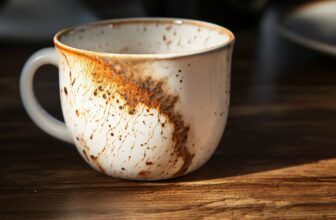
White tea is renowned for its delicate and captivating fragrance that delights the senses. When you brew a cup of white tea, the aroma that wafts through the air is truly enchanting. But what exactly does white tea smell like? Let’s unravel the mystery.
White tea has a unique and subtle fragrance that is both sweet and floral. It exudes a refreshing aroma that can transport you to a serene garden blooming with fresh flowers. The scent is reminiscent of a gentle breeze blowing through a field of blooming flowers, leaving a trail of tranquility in its wake.
The fragrance of white tea comes from the “white hairs” on the tea leaves. These delicate hairs contain aromatic compounds that the tea plant absorbs from its environment. This natural essence is preserved during the minimal processing of white tea, allowing its fragrance to shine through.
Depending on the variety of white tea, you may also detect hints of earthiness in its scent. Some white teas have a subtle grassy or hay-like aroma, evoking images of a countryside landscape. It’s as if you can almost smell the pure, untouched nature in every sip.
But white tea doesn’t stop at floral and earthy notes. Certain cultivars and growing conditions can infuse white tea with fruity or nutty scents. Imagine the delightful aroma of ripe berries or the comforting fragrance of roasted nuts. These additional layers of scent add complexity and intrigue to the white tea experience.
Key Takeaways:
- White tea has a delicate and captivating fragrance that is both sweet and floral.
- The fragrance of white tea comes from the “white hairs” on the tea leaves, which contain aromatic compounds acquired from the growing environment.
- White tea’s minimal processing helps retain its natural aroma.
- Some varieties of white tea also have earthy, grassy, hay-like scents.
- Certain white teas can have fruity or nutty aromas, depending on the cultivar and growing conditions.
The Delicate Floral Notes of White Tea
The fragrance of white tea is characterized by delicate floral notes that evoke a sense of tranquility and natural beauty. When you take a whiff of a freshly brewed cup of white tea, you’ll be greeted by a refreshing aroma that is reminiscent of blooming flowers. The subtle, yet captivating scent of white tea is often compared to the smell of fresh flowers, like jasmine or magnolia.
What sets white tea apart from other types of tea is its gentle and nuanced fragrance. It’s not overpowering or heavy, but rather light and ethereal. As you savor each sip, the floral notes dance on your palate, creating a harmonious sensory experience. The delicate fragrance of white tea creates a serene atmosphere, allowing you to unwind and find solace in its natural aroma.
White tea gets its floral aroma from the “white hairs” on the tea leaves, which contain fragrance compounds acquired from the tea plant’s growing environment. These compounds infuse the tea with a subtle sweetness and a hint of earthiness, enhancing the overall fragrance. The minimal processing of white tea helps preserve these natural aromas, allowing you to fully appreciate and enjoy the delicate floral notes in every cup.
The delicate floral notes of white tea make it a versatile fragrance that can be incorporated into your home. You can create a soothing ambiance by using a whole home scenting diffuser that disperses the fragrance throughout your living space. Alternatively, you can make a room spray with white tea essential oil or add a few drops of white tea essential oil to your cleaning products for a refreshing and invigorating scent. Another option is to make a potpourri using dried white tea leaves, which will fill your home with a subtle floral aroma.
Whether you’re seeking a moment of tranquility or looking to enhance the atmosphere in your home, the delicate floral notes of white tea provide a refreshing and invigorating aroma. Embrace the natural beauty of white tea and indulge in its captivating fragrance.
The Subtle Earthiness of White Tea
In addition to its floral notes, white tea exhibits a subtle earthiness, reminiscent of freshly cut grass and the aroma of a sunlit meadow. This delicate balance of fragrances adds depth and complexity to the overall sensory experience of white tea. The earthy undertones create a soothing and natural aroma that is both refreshing and comforting.
White tea’s connection to nature is further emphasized by its grassy and hay-like scents. These subtle hints of the outdoors transport you to a serene meadow, where the sun gently warms the grass beneath your feet. The fragrance of white tea captures this essence, allowing you to bring a touch of nature into your daily life.
The earthiness of white tea is derived from the growing environment and the presence of aromatic compounds in the tea leaves. As the tea plant absorbs nutrients from the soil and interacts with its surroundings, it acquires these compounds, which contribute to its unique fragrance. This natural process, combined with the minimal processing of white tea, allows the tea leaves to retain their innate aromas.
Aromas of White Tea
The subtle earthiness of white tea is just one aspect of its aromatic profile. Depending on the cultivar and growing conditions, white tea can also exhibit fruity or nutty scents. These additional aromas enhance the sensory experience and provide a delightful variety of fragrances to explore.
Whether you prefer the delicate floral notes, the subtle earthiness, or the fruity and nutty scents, white tea offers a sensory journey like no other. Its fragrance can transport you to a serene meadow or evoke memories of delightful fruity aromas. By embracing the captivating fragrance of white tea, you can create a tranquil atmosphere in your home and infuse your life with the beauty of nature.
The Role of Fragrant Compounds in White Tea
The captivating fragrance of white tea is derived from the aromatic compounds present in the delicate “white hairs” on the tea leaves. These fragrance compounds are acquired from the tea plant’s environment and contribute to the unique scent of white tea. Unlike other types of tea that may undergo extensive processing, white tea is minimally processed, which helps to retain its natural aroma.
White tea’s fragrance is often described as sweet, floral, and slightly earthy. It is reminiscent of the fresh scent of flowers, hay, or freshly cut grass. This beautiful fragrance is a result of the aromatic compounds infused into the tea leaves during the plant’s growth. The presence of these compounds gives white tea its distinctive and alluring aroma.
As the tea plant grows, the compounds in its environment, such as the soil, air, and surrounding vegetation, impart their fragrances onto the tea leaves. These compounds are then preserved in the delicate “white hairs” or trichomes that cover the leaves. When brewed, these fragrant compounds are released, creating a sensory experience that is both enticing and calming.
The Science Behind White Tea’s Fragrance
The fragrance compounds found in white tea are a result of chemical processes that occur within the tea plant. These compounds, known as volatiles, are responsible for the aroma that we perceive. They can vary depending on the tea plant’s cultivar, growing conditions, and even the time of harvest.
Some white teas may have fruity or nutty scents, reflecting the specific cultivar and environmental factors. For example, teas grown in cooler climates may develop more pronounced fruity notes, while those grown in sunnier regions may have a nuttier aroma. These subtle variations in fragrance add to the complexity and depth of white tea.
The delicate and captivating fragrance of white tea, with its aromatic compounds acquired from the tea plant’s environment, is truly a sensory delight. It is a testament to the minimal processing and careful cultivation that goes into creating this exquisite beverage. The next time you savor a cup of white tea, take a moment to appreciate the intricate and captivating aromas that make it a truly unique experience.
| Aromatic Compounds | Example Fragrances |
|---|---|
| Esters | Fruity, floral |
| Aldehydes | Citrus, grassy |
| Terpenes | Pine, floral |
Varieties of White Tea’s Aromas
White tea exhibits a diverse range of aromas, with some varieties boasting fruity or nutty scents, influenced by the specific cultivar and growing conditions. The delicate and subtle fragrance of white tea is often described as sweet, floral, and slightly earthy. It is frequently compared to the smell of fresh flowers, hay, or freshly cut grass. This unique aroma is a result of the “white hairs” on the tea leaves, which contain fragrance compounds acquired from the environment in which the tea plants grow.
“White tea’s fragrance is influenced by the cultivar and growing conditions.”
White tea’s natural aroma is retained due to its minimal processing. It undergoes minimal oxidation and is not rolled or twisted like other types of tea. This gentle processing allows the fragrance compounds in white tea to remain intact, resulting in a more pronounced and authentic scent.
| Variety | Aroma |
|---|---|
| Bai Hao Yin Zhen (Silver Needle) | Delicate and floral |
| Bai Mu Dan (White Peony) | Mildly fruity with a hint of nuttiness |
| Shou Mei (Longevity Eyebrow) | Subtle and earthy |
Each variety of white tea offers its own unique aroma profile, providing tea lovers with a diverse sensory experience. Whether you prefer a fruity, nutty, or earthy scent, there’s a white tea variety for every palate. The specific cultivar and growing conditions play a significant role in shaping the aromatic qualities of each type of white tea.
White tea’s tantalizing fragrance can be enjoyed beyond the teacup. You can infuse your home with the delightful scent of white tea by using a whole home scenting diffuser, creating a room spray, or using an essential oil air freshener. Adding a few drops of white tea essential oil to your cleaning products or making a potpourri with dried white tea leaves can also help bring the invigorating aroma into your living space.
“Enhance your home with the invigorating fragrance of white tea.”
Enhancing Your Home with White Tea Fragrance
Bring the delightful fragrance of white tea into your home with these simple and effective methods of scenting. White tea has a delicate, subtle fragrance that is sweet, floral, and slightly earthy. It is often compared to the smell of fresh flowers, hay, or freshly cut grass, creating a refreshing and inviting atmosphere.
One easy way to infuse your home with the scent of white tea is by using a whole home scenting diffuser. These diffusers release a continuous, subtle fragrance throughout your living space, filling the air with the pleasing aroma of white tea. Simply add a few drops of white tea essential oil to the diffuser and enjoy the relaxing ambiance it creates.
If you prefer a more targeted approach, you can create your own room spray using white tea essential oil. Fill a spray bottle with water and add a few drops of the oil. Shake well before use and spritz the mixture around your home to instantly freshen up any room with the delightful fragrance of white tea.
For those who enjoy DIY projects, you can also incorporate white tea fragrance into your cleaning routine. Add a few drops of white tea essential oil to your homemade cleaning products, such as all-purpose sprays or floor cleaners. Not only will your home be sparkling clean, but it will also be filled with the subtle, soothing scent of white tea.
Create a white tea potpourri
Another way to enjoy the aroma of white tea is by creating your own potpourri. Mix dried white tea leaves with dried flowers, such as jasmine or rose petals, in a bowl. Add a few drops of white tea essential oil to enhance the fragrance. Display the potpourri in small bowls around your home, or place it in decorative sachets to hang in closets or drawers, bringing the delightful scent of white tea to every corner.
By incorporating the fragrance of white tea into your home, you can create a soothing and relaxing environment. Whether using a diffuser, room spray, essential oils, or potpourri, the subtle and sweet aroma of white tea will help promote a sense of calm and tranquility, inviting you to unwind after a busy day.
| Methods of Scenting | Benefits |
|---|---|
| Whole home scenting diffuser | Continuous fragrance throughout the home |
| Room spray | Instantly freshen up any room |
| Essential oil air freshener | Customize the scent intensity |
| Adding essential oils to cleaning products | Clean and freshen your home simultaneously |
| Potpourri | Decorative scent accents throughout the home |
The Evolution of White Tea Fragrance
As white tea ages, its fragrance undergoes a captivating transformation, evolving from a reed and weeds fragrance in its youth to a subtle rice or barley scent in its maturity. This metamorphosis is a natural process that occurs over time, resulting in a unique olfactory experience.
When white tea is young, it exudes a delicate fragrance reminiscent of reed and weeds, giving it a fresh and grassy aroma. This youthful scent is often described as light and airy, like a gentle breeze rustling through a field of wildflowers. It carries a sense of purity and vitality, reflecting the youthful essence of the tea leaves.
However, as white tea ages, its fragrance deepens and becomes more complex. The scent slowly transforms into a subtle rice or barley aroma, acquiring deeper and earthier notes. This evolution is influenced by various factors, including the aging process, storage conditions, and the interaction between the tea leaves and the surrounding environment.
The captivating transformation of white tea fragrance is a testament to its remarkable nature. It showcases the intricate interplay between time, nature, and the art of tea-making. Each stage of the aging process unveils new dimensions of aroma, offering an immersive sensory experience for tea enthusiasts.
| Ages of White Tea | Fragrance |
|---|---|
| Youthful | Reed and weeds |
| Mature | Subtle rice or barley |
Notable Quotes:
“The evolution of white tea fragrance is a testament to the beauty and complexity of this beloved beverage.” – Tea connoisseur
Key Takeaways:
- White tea undergoes a captivating transformation as it ages, changing from a reed and weeds fragrance to a subtle rice or barley scent.
- The fragrance of young white tea is light, fresh, and grassy, reminiscent of reed and weeds in its youth.
- With time, white tea develops deeper and earthier notes, acquiring a subtle rice or barley aroma in its maturity.
- The aging process, storage conditions, and interaction with the environment contribute to the evolution of white tea fragrance.
- The transformation of white tea fragrance offers a unique and immersive sensory experience for tea enthusiasts.
The Alluring Fragrance of White Tea
White tea’s alluring fragrance, with its delicate floral notes and subtle earthiness, captivates tea lovers around the world, making it a cherished sensory experience. The sweet, floral scent of white tea is often compared to the aroma of fresh flowers, while its slightly earthy undertones evoke the essence of hay or freshly cut grass.
This enchanting fragrance originates from the “white hairs” that cover the tea leaves, containing fragrance compounds acquired from the tea plant’s growing environment. Due to its minimal processing, white tea retains its natural aroma, creating a truly authentic olfactory experience.
Not only does white tea offer a delightful bouquet, but it also boasts a variety of scents depending on the cultivar and growing conditions. Some varieties of white tea exhibit fruity or nutty aromas, adding another layer of complexity to its fragrance profile.
To bring the captivating aroma of white tea into your home, there are numerous options available. You can use a whole home scenting diffuser to infuse the air with the scent of white tea, or create your own room spray by combining white tea essential oil with water. Adding a few drops of white tea essential oil to your cleaning products can also leave a refreshing fragrance throughout your space. For a touch of elegance, consider making a potpourri using dried white tea leaves.
Furthermore, white tea can contribute to creating a relaxing and inviting atmosphere, making it ideal for winding down after a long day or promoting a restful night’s sleep. As white tea ages, its fragrance may undergo a transformation. Young white tea tends to have a reed and weeds smell, while aged white tea develops a comforting rice or barley scent.
FAQ
Q: What does white tea smell like?
A: White tea has a delicate, subtle fragrance that is sweet, floral, and slightly earthy. It is often compared to the smell of fresh flowers, hay, or freshly cut grass.
Q: Where does the fragrance of white tea come from?
A: The fragrance of white tea comes from the “white hairs” on the tea leaves, which contain fragrance compounds acquired from the growing environment. White tea’s minimal processing helps retain its natural aroma.
Q: Are there different varieties of white tea fragrance?
A: Yes, different varieties of white tea can have fruity or nutty scents, depending on the cultivar and growing conditions.
Q: How can I enhance my home with white tea fragrance?
A: There are several ways to enhance your home with white tea fragrance, such as using a whole home scenting diffuser, making a room spray, using an essential oil air freshener, adding essential oils to cleaning products, or creating a potpourri.
Q: Does white tea fragrance change over time?
A: Yes, as white tea ages, its fragrance may transform. Young white tea may have a reed and weeds smell, while aged white tea may develop a rice or barley scent.










